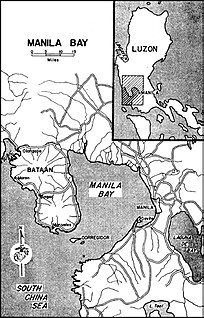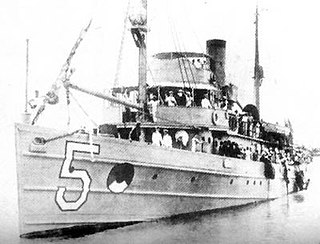
Corregidor Island is an island located at the entrance of Manila Bay in the southwestern part of Luzon in the Philippines. Due to this location, Corregidor has historically been fortified with coastal artillery batteries to defend the entrance of Manila Bay and Manila itself from attacks by enemy warships. Located 48 kilometres (30 mi) inland, Manila is the largest city and the most important seaport in the Philippines for centuries, from the colonial rule of Spain, Japan, and the United States, up until the establishment of the Third Philippine Republic in 1946.

The Harbor Defenses of Manila and Subic Bays were a United States Army Coast Artillery Corps harbor defense command, part of the Philippine Department of the United States Army from circa 1910 through early World War II. The command primarily consisted of four forts on islands at the entrance to Manila Bay and one fort on an island in Subic Bay.

Fort Mills was the location of US Major General George F. Moore's headquarters for the Philippine Department's Harbor Defenses of Manila and Subic Bays in early World War II, and was the largest seacoast fort in the Philippines. Most of this Coast Artillery Corps fort was built 1904–1910 by the United States Army Corps of Engineers as part of the Taft program of seacoast defense. The fort was named for Brigadier General Samuel Meyers Mills Jr., Chief of Artillery 1905–1906. It was the primary location of the Battle of Corregidor in the Japanese invasion of the Philippines in 1941–42, and of the recapture of Corregidor in February 1945, both in World War II.

The United States Asiatic Fleet was a fleet of the United States Navy during much of the first half of the 20th century. Before World War II, the fleet patrolled the Philippine Islands. Much of the fleet was destroyed by the Japanese by February 1942, after which it was dissolved, and the remnants incorporated into the naval component of the South West Pacific Area command, which eventually became the Seventh Fleet.

Motor Torpedo Boat Squadron Three was a United States Navy squadron based at Cavite, Philippines, from September 1941 to mid-April 1942. It was commanded by Lieutenant John D. Bulkeley and made up of six motor torpedo boats: PT-31, PT-32, PT-33, PT-34, PT-35, and PT-41, the last as the squadron flagship. The other six boats of the squadron remained at Pearl Harbor, Hawaii, and were there when war broke out, eventually being shipped to the Solomons.

USS Canopus (AS-9) was a submarine tender in the United States Navy, named for the star Canopus.

USS Tanager (AM-5) was an Lapwing-class minesweeper acquired by the U.S. Navy for the dangerous task of removing mines from minefields laid in the water to prevent ships from passing.

The first USS Pigeon (AM-47/ASR-6) was a Lapwing-class minesweeper of the United States Navy. She was later converted to a submarine rescue ship. She was named for the avian ambassador, the pigeon.

Lanikai, was a schooner-rigged diesel powered yacht in service with the United States Navy during both World War I and World War II, before being transferred to the Royal Australian Navy.

USS Genesee (AT-55), formerly Monocacy, was a fleet tug in the U.S. Navy in World War I and World War II built in 1905. She was scuttled on 5 May 1942 at Corregidor to avoid capture. Nevertheless, she was raised by the Japanese and designated as Patrol Boat No. 107. She was sunk by American planes on 5 November 1944.

The first USS Luzon (PG-47) was laid down 20 November 1926 by the Kiangnan Dock and Engineering Works, Shanghai, China; launched 12 September 1927; sponsored by Miss Mary C. Carter, daughter of Commander Andrew F. Carter, USN; and commissioned 1 June 1928.

The Port of Subic Bay is in the Subic Bay Freeport Zone, the former U.S. Naval Base Subic Bay, on Subic Bay in the Philippines. It is one of the busiest, largest, historical and most important of ports in the Philippines. The Port is operated and managed by the Subic Bay Metropolitan Authority (SBMA).

USS Dewey (YFD-1) was a floating dry dock built for the United States Navy in 1905, and named for American Admiral George Dewey. The auxiliary floating drydock was towed to her station in the Philippines in 1906 and remained there until scuttled by American forces in 1942, to prevent her falling into the hands of the invading Japanese.
Trabajador was a 111 foot (33.8 m) tug launched in 1931 by Hong Kong & Whampoa Dock Co., Ltd. for Visayan Stevedore-Transportation Company and registered as a United States vessel in Iloilo, Philippines.
Maryann, sometimes seen as Maryanne or Mary Anne, was a yacht requisitioned and converted by the United States Navy during the defense of the Philippines in World War II and destroyed 5 May 1942 at Corregidor to prevent capture. The yacht was "in service" and not commissioned.
Fisheries II was a vessel requisitioned by the United States Navy during the defense of the Philippines during World War II. The vessel was "in service" and not commissioned.

Q-111 Luzon was a motor torpedo boat of the United States Army during World War II as part of the Offshore Patrol based at Manila.
Q-112 Abra was a motor torpedo boat of the United States Army during World War II as part of the Offshore Patrol based at Manila.

BRP Banahaw was a British-built yacht that later served as the presidential yacht of the Commonwealth of the Philippines.

San Felipe (YFB-12) (ex-Engineer) was a United States Army steel tugboat that later served as a ferryboat in the U.S. Navy and as an Imperial Japanese Army transport during World War II.













